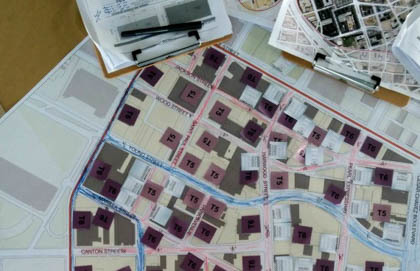This article is the second half of Social Cities director Milton Friesen's report from a recent trip to Dallas for the Congress for the New Urbanism. For part I, which looked at the workshop and the code, click here.
The Choices
It is worth asking why we would want to consider this alternative way of designing our communities and cities. If our current way of building and developing are deemed sufficient, then form-based codes are a distraction or a peculiar niche.
If, however, our current patterns of spreading out, being fully dependent on cars, and keeping various uses of city space completely separate make it nearly impossible to make substantive changes to our over-use of materials, land, fuel, and other resources, then the possibility that we could bake more intelligent and efficient ways of living into the spatial design of our cities is appealing and needed.
The theme that the Congress for the New Urbanism president, Lynne Richards, challenged us with during her presidential address was to continue to focus on “building places people love.” It may be that the places we love are also very much like the places we need.
The Outcomes
By the end of the day, working amid the street noise, sun, and constant collegial exchanges, we had decided which streets would form the A level street network (best for pedestrian, exchange, and intensity), which would be the B level network (used for delivering freight and moving cars), what the levels of building height, design, and density would be block-by-block, and how our various proposals would integrate with existing boundary spaces.
Our goal was to propose a way of supporting downtown development that would give rise to human flourishing through intelligent infrastructure. While this was an exercise and not something that would be enacted, each proposal reflected a collaborative process (workshop participants in this case, a wider network of citizens in actual practice) that yielded fruitful and pleasant street connections.
The imagined network of buildings, streets, sidewalks, and corridors led to new relationships between the farmers market and downtown, considerations for traffic flows in and out of the area, and levels of building density that would improve street-level life over time rather than detract from it. It also left a full range of opportunities open for commercial and residential negotiations over time.
The Needs
What we need from our communities and cities today is not as different from what we needed in the past as we may think. True, our expectations for a wireless connection are different than they were in a Madrid in the 15th century, but our need for mobility, equality, significance, and meaningful connection to a wide range of people is not different.
We know that geographical distance degrades social ties. We also know that the weaker social ties are, the less we trust each other. And where trust is lower and neighbourly interactions are fewer, we don’t do as well (not nearly, in some cases) psychologically and physically. It has always been difficult to maintain a rich network of friends and family, but we are learning that the design of our communities can make that challenge even more difficult.
Baking in design ideas that are compatible with social, ecological, economic and other aspects of human flourishing seems prudent. As we develop new places, it is worth thinking about how the interactions of law and design, paper and code, could give rise to what we love and need. What we have already built can be enriched, re-worked, or adapted. There is a great deal of hope in thinking about how the seemingly dull and seldom-seen DNA of our cities could be reworked to generate greater equity, enhanced belonging, and decreased ecological impact—a more human habitat. Seems worthwhile.









